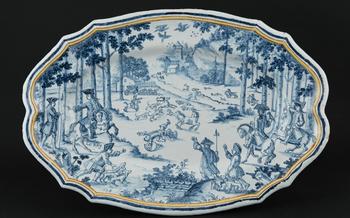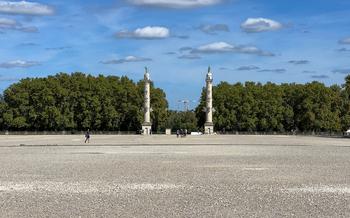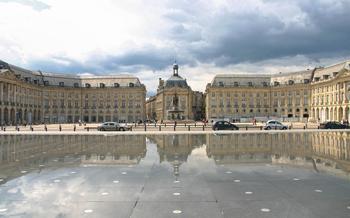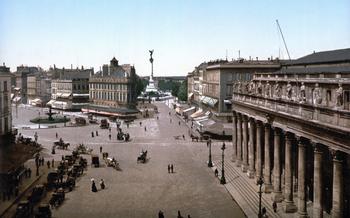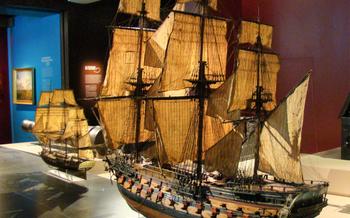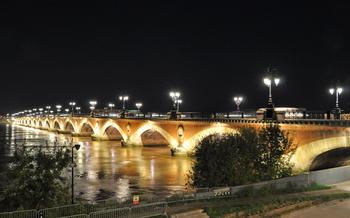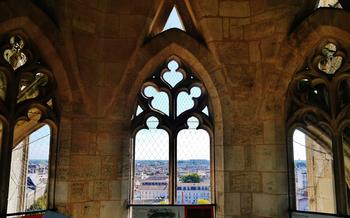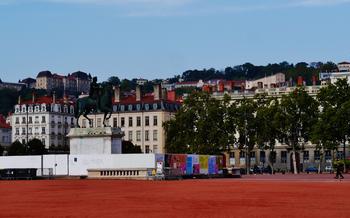
Place des Quinconces
- Place des Quinconces: A Symbol of Bordeaux's Grandeur
- The Monument aux Girondins: A Homage to Revolutionary Heroes
- The Grand Théâtre: A Masterpiece of Neoclassical Architecture
- The Quais de Bordeaux: Strolling Along the Garonne River
- The Darwin Ecosystème: A Hub for Sustainable Innovation
- The Marché des Capucins: A Vibrant Market Hall
- Cathédrale Saint-André: A Gothic Masterpiece
- The Pey-Berland Tower: A Panoramic Viewpoint
- The Porte Cailhau: A Gateway to the City
- Insider Tip: Explore Bordeaux by Bike
Place des Quinconces: A Symbol of Bordeaux's Grandeur
In the heart of Bordeaux, a city celebrated for its elegance and rich history, lies the Place des Quinconces, a majestic square that epitomizes the city's grandeur. With its sprawling expanse of 126,000 square meters, it ranks among the largest public squares in Europe, surpassed only by a few notable counterparts. The square's inception dates back to the 18th century when it was used as a military parade ground, a testament to its significant role in shaping Bordeaux's identity. Today, the Place des Quinconces stands as a vibrant hub of activity, a place where locals and tourists alike gather to soak in the atmosphere and admire the architectural wonders that surround it.
The Monument aux Girondins: A Homage to Revolutionary Heroes
The Place des Quinconces is home to one of Bordeaux's most iconic landmarks: the Monument aux Girondins. This imposing monument stands as a tribute to the Girondins, a group of moderate republicans who played a significant role in the early stages of the French Revolution.
The monument was designed by the renowned sculptor Frédéric Auguste Bartholdi, known for his creation of the Statue of Liberty. Completed in 1895, the monument features a towering bronze column topped by a statue of Liberty holding a torch, symbolizing the ideals of the French Revolution.
The monument's base is adorned with sculptures representing the Girondins and scenes from the revolution. These intricate carvings provide a vivid portrayal of the tumultuous events that shaped France during that period.
The Monument aux Girondins has a controversial history. During World War II, it was dismantled by the occupying German forces, who considered it a symbol of French resistance. The monument was restored after the war and remains a poignant reminder of the sacrifices made during the revolution.
Today, the Monument aux Girondins is a popular tourist attraction, offering a glimpse into the rich history of Bordeaux and the French Revolution. Visitors can climb the steps to the top of the column for a panoramic view of the city and the surrounding area. Guided tours are also available, providing in-depth insights into the monument's history, symbolism, and artistic significance.
The Grand Théâtre: A Masterpiece of Neoclassical Architecture
The Grand Théâtre, a splendid emblem of Bordeaux's cultural heritage, stands majestically on the Place de la Comédie. Constructed between 1773 and 1780 under the direction of architect Victor Louis, this architectural masterpiece is a testament to the city's flourishing cultural scene during the 18th century.
The theater's imposing façade, adorned with twelve Corinthian columns and intricate bas-reliefs, exudes an aura of grandeur that befits its status as a leading performing arts venue. Inside, the auditorium's horseshoe-shaped design and lavish décor create an intimate and opulent atmosphere for audiences to enjoy a diverse range of performances.
Over the years, the Grand Théâtre has hosted countless legendary artists and prestigious productions, including ballets, operas, and plays. Its stage has witnessed the talents of renowned performers such as Sarah Bernhardt, Enrico Caruso, and Plácido Domingo. The theater's reputation as a cultural landmark has transcended national borders, attracting theater enthusiasts from around the world.
For those seeking an immersive cultural experience in Bordeaux, the Grand Théâtre offers guided tours that provide a fascinating glimpse into its history, architecture, and artistic legacy. Visitors can wander through the theater's opulent foyers, marvel at the intricate details of its grand staircase, and soak in the atmosphere of this iconic venue.
Practical Information:
- Ticket Prices: Prices for performances vary depending on the production and seating category.
- Show Schedules: Performances are held throughout the year, with evening shows typically starting at 8 pm.
- Guided Tours: Guided tours of the Grand Théâtre are available in multiple languages and offer insights into its history, architecture, and artistic significance.
The Quais de Bordeaux: Strolling Along the Garonne River
The Quais de Bordeaux, or Bordeaux quays, are a vibrant waterfront promenade that stretches alongside the majestic Garonne River. These picturesque quays have played a pivotal role in the city's maritime and commercial history, serving as a gateway to the Atlantic Ocean and a hub for international trade. Today, the Quais de Bordeaux have been transformed into a captivating urban oasis, inviting visitors and locals alike to stroll, relax, and soak in the city's rich heritage.
As you amble along the quays, you'll be greeted by an array of architectural landmarks that showcase Bordeaux's architectural diversity. Admire the grandeur of the Place de la Bourse, with its elegant 18th-century buildings and the iconic Miroir d'Eau, a mesmerizing water mirror that creates stunning reflections of the surrounding cityscape. Cross the majestic Pont de Pierre, a monumental stone bridge that connects the city center with the vibrant district of La Bastide. Marvel at the futuristic silhouette of the Cité du Vin, a museum dedicated to the world of wine, with its unique and captivating design that resembles a swirling glass of wine.
The Quais de Bordeaux offer a plethora of leisure activities for visitors of all ages. Take a leisurely boat tour or a romantic cruise along the Garonne River, offering breathtaking views of the city's landmarks from a unique perspective. Admire the colorful facades of the historic warehouses that line the quays, now transformed into charming restaurants, inviting cafés, and trendy boutiques. Indulge in a delightful meal at one of the many riverside eateries, savoring the flavors of local cuisine while enjoying the tranquil ambiance of the riverfront.
For a more active experience, rent a bicycle and embark on a scenic cycling route along the designated bike paths that run alongside the quays. Explore the nearby Jardin Public, a tranquil oasis of greenery, or venture further to the Darwin Ecosystème, a vibrant hub for sustainable innovation and community-driven projects.
The Quais de Bordeaux are easily accessible by foot, bicycle, or public transportation, making them a convenient starting point for exploring the city's many attractions. With their captivating blend of history, architecture, and vibrant atmosphere, the Quais de Bordeaux offer an unforgettable experience for every visitor to this charming French city.
The Darwin Ecosystème: A Hub for Sustainable Innovation
Concept and Mission:
The Darwin Ecosystème is a unique and innovative project that is dedicated to promoting sustainable development and the circular economy. It is a thriving hub for eco-friendly businesses, startups, and organizations that are committed to creating a positive impact on the environment and society. The Darwin Ecosystème aims to inspire and empower individuals and communities to adopt sustainable practices and contribute to a greener future.
Unique Features:
The Darwin Ecosystème is housed in a former military barracks, which has been transformed into a vibrant and sustainable community space. The eco-district features innovative architecture, green spaces, and community initiatives that showcase sustainable solutions and circular economy principles. Visitors can explore the various buildings and facilities, which include co-working spaces, workshops, a rooftop garden, and an urban farm.
Activities and Events:
The Darwin Ecosystème is a hub for a wide range of activities and events that promote sustainable living and innovation. Visitors can attend workshops, markets, exhibitions, and cultural events that focus on topics such as renewable energy, waste reduction, and sustainable food production. The eco-district also hosts regular talks, conferences, and networking opportunities for entrepreneurs, innovators, and change-makers.
Practical Information:
The Darwin Ecosystème is located in the Bassins à Flot district, a former industrial area that is now undergoing a transformation into a sustainable urban neighborhood. The eco-district is easily accessible by public transportation, and there are bike rental stations nearby for those who prefer to explore on two wheels. Visitors can find a variety of restaurants, cafes, and shops in the area, many of which offer organic and locally sourced products.
The Marché des Capucins: A Vibrant Market Hall
In the heart of Bordeaux, nestled between the Garonne River and the Saint-Michel district, lies the Marché des Capucins, a bustling market hall that has been a beloved institution among locals and visitors alike since its inception in 187Originally a wholesale market for agricultural produce, the Marché des Capucins has evolved into a vibrant and diverse marketplace, offering a captivating blend of culinary delights, artisanal treasures, and cultural experiences.
The market's striking architecture, a testament to the city's rich architectural heritage, features a majestic glass and iron structure that allows natural light to flood the interior, creating a bright and airy ambiance. Within its spacious halls, over 100 vendors proudly showcase their finest offerings, ranging from fresh fruits and vegetables, aromatic cheeses, and succulent seafood to artisanal bread, handmade chocolates, and delectable pastries.
Indulge in tantalizing food experiences as you navigate the vibrant stalls, sampling fresh oysters paired with a glass of crisp white wine, savoring the flavors of traditional Basque tapas, or embarking on a culinary adventure with exotic spices and ingredients from around the world. The market also hosts regular cooking classes and workshops, providing an opportunity to learn from local chefs and culinary experts while immersing yourself in the region's rich gastronomic traditions.
Beyond its culinary offerings, the Marché des Capucins is a cultural hub that hosts a variety of events throughout the year. From art exhibitions and live music performances to seasonal festivals and themed markets, there's always something exciting happening at this vibrant marketplace. Whether you're a foodie, an art enthusiast, or simply looking for a unique and authentic Bordeaux experience, the Marché des Capucins promises an unforgettable adventure for all.
Cathédrale Saint-André: A Gothic Masterpiece
Standing tall in the heart of Bordeaux, the Cathédrale Saint-André is a testament to the city's rich history and architectural prowess. Its construction, spanning over several centuries, began in the 11th century and continued until the 16th century, resulting in a harmonious blend of Romanesque and Gothic styles.
The cathedral's façade, adorned with intricate carvings and sculptures, offers a glimpse into the biblical narratives and the lives of saints. The interior is equally awe-inspiring, with its soaring vaulted ceilings, stained glass windows depicting scenes from the Bible, and elaborate altarpieces that showcase the artistry and devotion of medieval craftsmen.
As a center of worship and pilgrimage, the Cathédrale Saint-André holds immense religious significance for the people of Bordeaux and beyond. Pilgrims from across Europe and beyond have flocked to the cathedral to seek spiritual guidance, offer prayers, and pay homage to the relics of Saint Andrew, the patron saint of Bordeaux.
Visitors to the cathedral can explore its many chapels, each dedicated to a different saint or purpose. The Chapelle Saint-Jean-Baptiste, for example, houses the tomb of the cathedral's founder, Archbishop Geoffroy de Lorges, while the Chapelle Sainte-Catherine is adorned with stunning frescoes depicting the life of Saint Catherine.
Admission to the Cathédrale Saint-André is free of charge, allowing visitors to immerse themselves in its sacred atmosphere and marvel at its architectural splendor. Guided tours are also available, providing insights into the cathedral's history, symbolism, and the stories behind its many artistic treasures.
The Pey-Berland Tower: A Panoramic Viewpoint
Rising majestically beside the Cathédrale Saint-André, the Pey-Berland Tower beckons visitors with the promise of breathtaking panoramic views of Bordeaux. Constructed in the 15th and 16th centuries, this Gothic masterpiece stands as a testament to the city's rich architectural heritage. Its intricate carvings and delicate tracery are a sight to behold, showcasing the exceptional craftsmanship of its builders.
Ascend the tower's 233 steps, and you will be rewarded with an unparalleled perspective of Bordeaux's urban tapestry. From this vantage point, the city's iconic landmarks, such as the Place de la Bourse and the Pont de Pierre, appear like miniature wonders, while the Garonne River meanders gracefully through the cityscape. On a clear day, your gaze can extend beyond the city limits, taking in the picturesque vineyards and rolling hills of the surrounding countryside.
The Pey-Berland Tower is not merely a viewpoint but also a significant historical monument. It initially served as a bell tower for the cathedral, and its bells once tolled to mark important events in the city's life. Over the centuries, the tower has undergone several restorations, preserving its grandeur for future generations to admire.
Practical Information:
- Admission Fees: A modest admission fee is required to climb the tower.
- Opening Hours: The tower is open to the public daily, except for certain holidays. Check the official website for specific hours.
- Accessibility: Unfortunately, the tower is not wheelchair accessible due to its narrow spiral staircase.
- Guided Tours: Guided tours of the tower are available, providing insights into its history and architectural features.
The Porte Cailhau: A Gateway to the City
In the heart of Bordeaux's historic center, stands the imposing Porte Cailhau, a captivating vestige of the city's medieval past and a testament to its rich architectural heritage. Built in the 15th century, this majestic gateway once served as a defensive structure, guarding the entrance to the city from potential invaders. Its strategic location on the banks of the Garonne River made it a crucial point of control for trade and commerce.
The Porte Cailhau stands as a remarkable example of late Gothic architecture, showcasing intricate carvings, decorative gargoyles, and elaborate turrets. Its imposing façade features two massive towers, adorned with delicate tracery and topped with crenellated battlements. The gateway's intricate details and architectural prowess reflect the artistry and craftsmanship of the era.
Beyond its historical significance, the Porte Cailhau holds cultural and symbolic importance for Bordeaux. It serves as a reminder of the city's resilience and its ability to adapt and evolve over time. Today, the gateway stands as a symbol of Bordeaux's rich past, welcoming visitors to explore the city's many wonders.
Practical Information:
- Location: Place de la Bourse, 33000 Bordeaux
- Accessibility: The Porte Cailhau is easily accessible on foot or by public transportation.
- Nearby Attractions: The gateway is situated near several other historic landmarks, including the Place de la Bourse, the Miroir d'Eau, and the Musée d'Aquitaine.
Insider Tip: Explore Bordeaux by Bike
Bordeaux is an incredibly bike-friendly city, with an extensive network of bike paths and designated cycling lanes, making it easy and enjoyable to explore the city on two wheels. Whether you prefer to pedal along the scenic Garonne River, discover the charming streets of the historic center, or venture further afield to explore the surrounding countryside, cycling is a fantastic way to experience the city's many attractions.
Several bike rental shops are located throughout Bordeaux, offering a variety of bikes to suit all needs and preferences, from traditional city bikes to electric bikes for those seeking a more leisurely ride. Once you have your bike, you can choose from various suggested cycling routes that cater to different interests and fitness levels.
For a leisurely ride, follow the "Quais de Bordeaux" route, which takes you along the picturesque Garonne River, offering stunning views of the city's landmarks. For a more challenging ride, venture out to the "Forêt du Bouscat," a beautiful forest located just a short distance from the city center, where you can cycle through shady trails and enjoy the tranquility of nature.
Remember to follow essential safety measures while cycling in Bordeaux. Wear a helmet, obey traffic regulations, and be mindful of other cyclists and pedestrians. Secure parking areas are available throughout the city, so you can lock your bike safely while exploring the city's attractions on foot.
Cycling in Bordeaux is a fantastic way to immerse yourself in the city's vibrant atmosphere, discover hidden gems, and appreciate its rich history and culture. So, grab a bike and pedal your way through the charming streets of this beautiful city.
